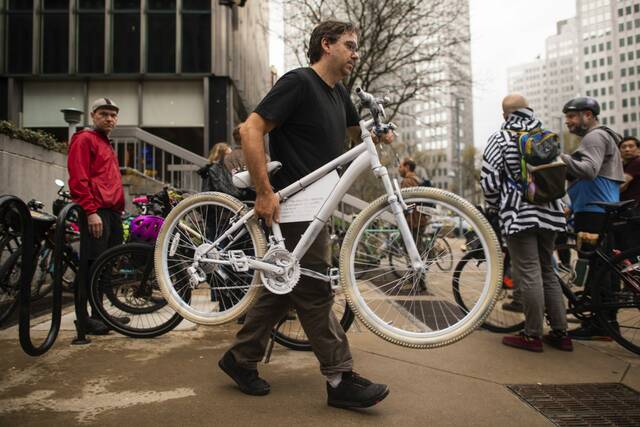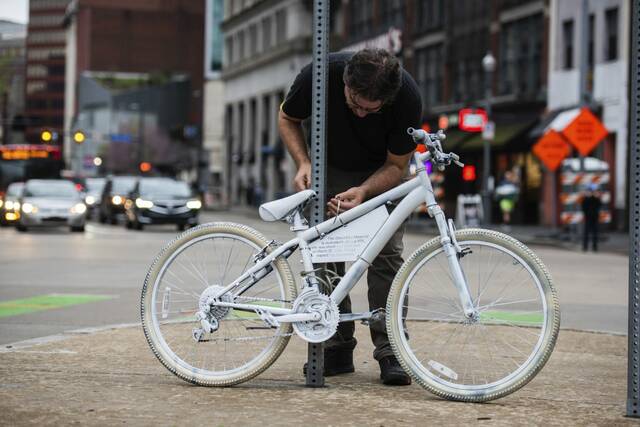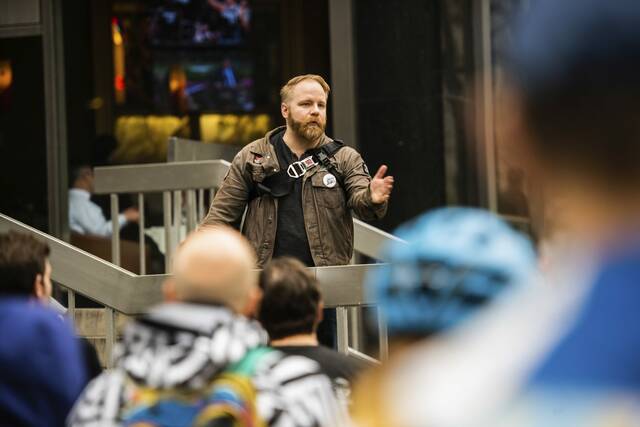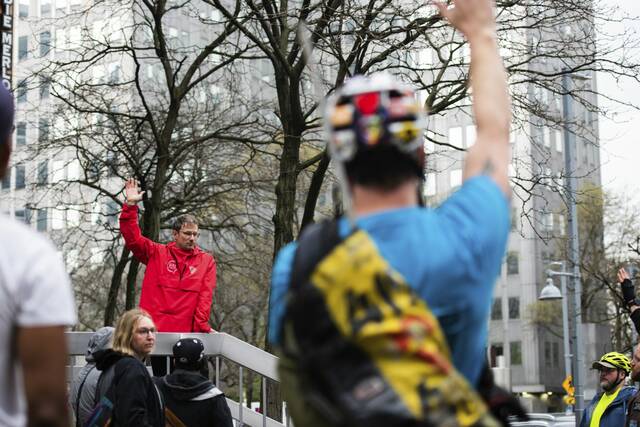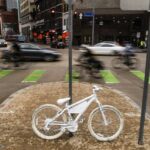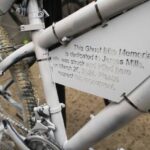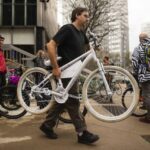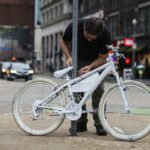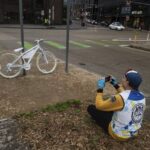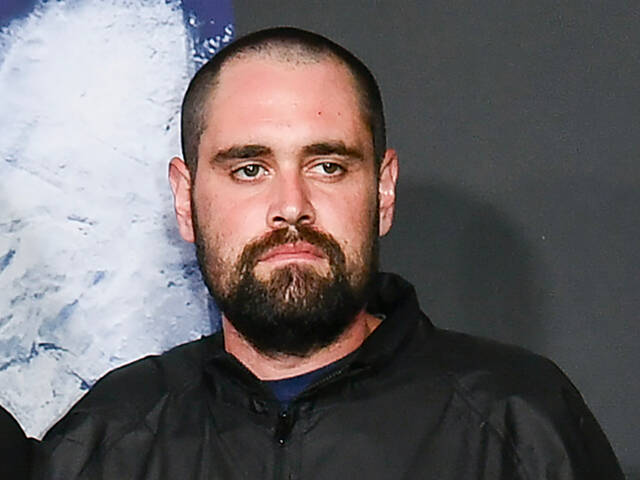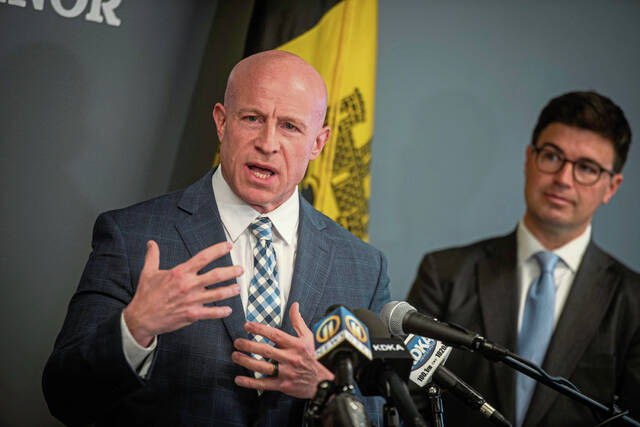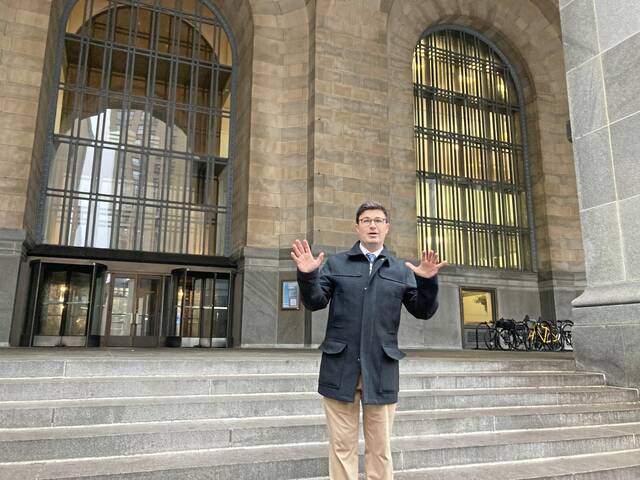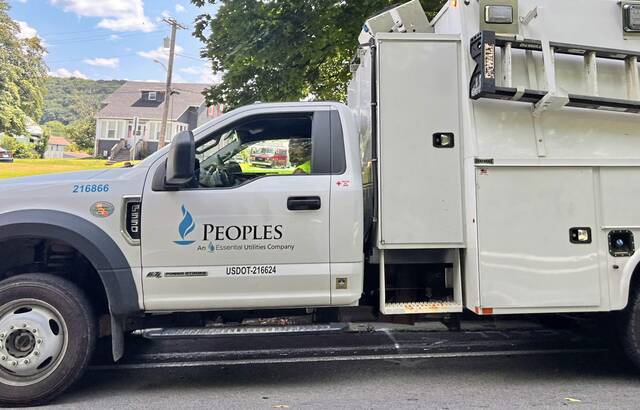A mountain bike culled from the junk bin of a North Point Breeze shop — its brakes stripped and its frame and wheels spray-painted white — emerged as a symbol Wednesday night for bike and pedestrian safety in Pittsburgh.
As rain flickered on and off Downtown after commuting traffic had calmed down for the day, safety advocates chained the “ghost bike” to a signpost on a concrete Liberty Avenue median.
It memorialized bicyclist James Mills, a 67-year-old Squirrel Hill man hit March 26 by a semi-truck while trying to cross that same intersection. He died four days later.
Armin Samii, who helped organize the vigil, bikes regularly on the route Mills took.
“It felt incredibly personal because you realize it could be you,” said Samii, 32, of Lawrenceville, a bicyclist who hasn’t owned a car since moving to Pittsburgh in 2019. “Nobody should die on our city streets, just trying to get around.”
More than 6,900 pedestrians were killed on U.S. roads in 2022, accounting for nearly one in every five traffic deaths, National Highway Traffic Safety Administration data shows. Nearly, 1,100 bicyclists were killed the same year.
About 1 in every 20 of the 20,247 crashes reported from 2018 to 2022 to Pittsburgh’s Department of Mobility and Infrastructure, or DOMI, involved a pedestrian or bicyclist, data shows.
Other fatal incidents
Emily Watson loved to read.
The Pittsburgh resident, a 29-year-old Point Park University alumna who worked for UPMC, also liked to trek up to Presque Isle Beach to watch the sun set over Lake Erie.
Watson became a city statistic at about 9:25 a.m. Nov. 29.
She crossed Terrace Street in Oakland — within feet of UPMC Presbyterian hospital, where she worked in the transport department — and a UPMC shuttle bus hit her, knocking her unconscious. Watson later died at an area hospital.
Watson was at least the second pedestrian killed recently near that intersection, a hilly area that cradles the Petersen Events Center and sits on what University of Pittsburgh students call the school’s “upper campus.”
A UPMC shuttle bus fatally struck Mary Flaherty, 76, of Monroeville on Sept. 17, 2020 as she walked near the intersection of Terrace and Buffalo streets at an unmarked crosswalk.
The city has records of other incidents.
At least 24 motor-vehicle accidents — 16 of them hit-and-runs — have occurred on that part of Terrace Street, according to data TribLive received through a Right To Know law request.
From 2013 through 2023, Pittsburgh police pulled over at least 117 motorists there, that data shows. Nearly one in every four drivers was stopped for ignoring a stop sign or running a nearby traffic light.
Problem intersections
The stretch of Terrace Street where Watson was killed is “a complex set of intersections and corridors” complicated further by the fact that many who drive on it aren’t familiar with Pittsburgh roads, said Pittsburgh Councilwoman Erika Strassburger, whose East End district includes that roadway.
The intersection of Terrace Street and Sutherland Drive, near the foot of Petersen Events Center, is one of several troubled intersections in “a compact and dense district,” Strassburger said.
Others include Fifth and Morewood avenues, an intersection within feet of Carnegie Mellon University’s campus and the border between Oakland and Shadyside, she said.
Elected leaders, including Strassburger, said they’ve tried to address troubled intersections along Shadyside’s Aiken Avenue — where nearly 60 crashes were reported over a span of five years. A planned “road diet” there might reduce the number of vehicle lanes.
“There are many of those intersections across the city,” Strassburger told TribLive. “If I had my druthers, I’d upgrade six intersections per year.”
Budgetary restrictions make that unlikely, she added.
Pittsburgh Mayor Ed Gainey’s office did not respond to numerous calls or emails seeking comment.
Officials at the University of Pittsburgh also “regularly work” with other agencies on road projects throughout its main campus in Oakland, spokesman Jared Stonesifer told TribLive on Wednesday.
“The university is an urban campus and, as such, we have frequent and intentional conversations with a wide array of internal and external stakeholders regarding the safety of our campus for bicyclists and pedestrians,” Stonesifer said.
Pitt officials are updating the school’s campus master plan, which Stonesifer said “will have a strong focus on pedestrian and bike safety and mobility.” Pitt, which does not own or maintain Oakland roadways such as Terrace Street, also spends about $250,000 annually in sidewalk repairs.
In 2020, the school redeveloped Bigelow Boulevard between Fifth and Forbes avenues.
A citizen’s detailed records
In addition to organizing safety-minded public events like Wednesday’s “ghost bike” vigil, Samii founded dashcam.bike, a company that sits at the intersection of technology and public policy.
The company, which Samii runs from his Lawrenceville home, provides bicyclists with an app to turn their bike trips into data-collection ventures.
When added to the city’s self-reported 311-system data, those reports help inform engineers for the Department of Mobility and Infrastructure, he said.
Pittsburgh’s 311 Response Center collects “non-emergency City of Pittsburgh concerns or questions,” such as the location of “near misses” between cars and pedestrians or bicyclists.
Samii said his app users have submitted about 4,000 reports to Pittsburgh’s 311 system since he formed his company during the covid-19 pandemic. More than 95% of all bike-related “near miss” reports to Pittsburgh’s 311 have come through his app.
“Bicyclists are constantly seeing the same things over and over,” Samii told TribLive.
Cars are chronically parked in Penn Avenue’s bike lanes, and Downtown intersections can be dangerous, Samii said. Most who travel the Steel City by bike know crash hotspots like The Terminal shopping center in the Strip District or the bustling Liberty Avenue business district in Bloomfield.
The data, though, is helping, Samii maintained.
The Lawrenceville-based group BikePGH had advocated for nearly a decade for Pittsburgh officials to install concrete blocks on Penn Avenue to stop cars from parking in bike lanes, Samii said.
Six months after dashcam.bike started feeding data to 311, the city installed the concrete.
“This really helped accelerate the timeline,” Samii said. “The stories plus the data made them act.”
The city’s coming around
Then, there’s Vision Zero.
BikePGH started advocating for the policy — which seeks to eliminate fatal vehicle crashes within city limits — in 2014, said Eric Boerer, the group’s advocacy director.
By 2021, under former Pittsburgh Mayor Bill Peduto, DOMI was spending part of $560,000 in grant money on policies such as Complete Streets, which sought to improve road safety by involving all users in street redesigns.
In March, Pittsburgh City Council doubled down on Vision Zero. The council reaffirmed its commitment to reducing fatal vehicle crashes through speed hump installations and similar projects.
City officials have dedicated $1.4 million this year to traffic safety — nearly double the amount budgeted for such efforts last year. The move came after 21 people, including seven pedestrians, died in vehicle crashes on Pittsburgh streets last year, according to DOMI data.
“These policies gave people the words to use,” Boerer told TribLive. “We never had this commitment to zero traffic fatalities before.”
Vision Zero held its first working meeting on Wednesday afternoon, city officials told TribLive.
“They understand the epidemic of traffic violence,” Samii told TribLive. “And they understand the need for it to be solved. That conversation would have never happened 10 years ago.”
Boerer also feels that, when it comes to bike and pedestrian safety, Gainey has picked up where Peduto left off.
“The mayor wants the city to be the safest city in America,” Boerer said. “This is part of that … and it’s our job to make sure the city, the administration, holds up to that commitment.”
‘We’re not there yet’
The skies were gray before dusk Wednesday as Samii led a cadre of bicyclists 20 to 30 strong on a one-mile loop around Penn Avenue in memory of James Mills, the bicyclist killed just two weeks ago.
They ended their ride at the intersection where he was fatally struck.
As TV crews filmed the mourners as they gathered near Gateway Center, one BikePGH staffer mounted a “POGOH” bike-share bike. Samii’s bike was decorated with colored duct tape, all hot-pink and teal. A man nearby wore a helmet emblazoned with stickers shouting things like “Tax-paying cyclist.”
“I would love to live in a city with zero bike or pedestrian fatalities,” one bike safety advocate, who identified himself only as “Landy,” said at Wednesday’s vigil. “But this white bike we dedicate to James Mills will serve as a stark reminder to me … that we’re not there yet, that we weren’t there to save his life.”
Ben Peoples said the “ghost bike,” a memorial concept that some say originated in Pittsburgh, resonated for him, too.
Peoples commutes by bike almost every day from his native Squirrel Hill to North Braddock. He’s been hit by a car at least once — on Reynolds Street in Point Breeze. He laughs that the driver was “super-apologetic.”
Peoples estimates he has a close call between his bike and a passing car about once a month.
He’s the man who prepared the “ghost bike,” first picking out an inoperable, 24-inch mountain bike from Free Ride Pittsburgh, a collective on Pittsburgh’s North Lexington Street.
Peoples took the bike to his yard Sunday and used a whole can of spray paint coloring it a ghostly white.
“It felt very meaningful to do it in James’ memory — in a way, all grieving rituals are like that,” said Peoples, 44. “You’re doing something to help you heal.
“It could’ve been any one of us.”




